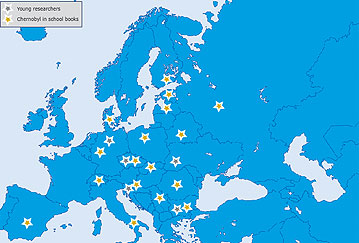What do pupils learn about the accident in school?
The task: We looked for various official teaching materials from our countries. Sources included current official schoolbooks, found either in the library or bookstore, or borrowed from friends or family members. Some participants had reference materials from teachers as well. It was interesting to see what everyone found at the end.
The results: Throughout Europe, information is mostly found in history books.
In physics and chemistry texts, Chernobyl is mentioned as an example of a nuclear accident of a great scale, in lessons such as “ionizing radiation” and “nuclear energy.” Geography books present information about how far the radiation cloud spread.
Biology books tell us how the accident affected people and the environment. The accident is also presented from political and sociological angles. Usually Chernobyl is not mentioned independently, but rather in the context of other more global and general topics such as the Soviet economy, Gorbachev’s era, the collapse of the Soviet Union, environmental issues and debates over nuclear energy.
Our research in Belarus, Czech Republic, Denmark, Finland, Latvia, Poland, Russia, Switzerland, and Ukraine indicated that the cause and consequences of the accident are represented in a very comprehensive manner. In Bulgaria, Germany, Romania, Serbia and Spain, Chernobyl is briefly mentioned, usually as an example of a nuclear catastrophe. We found no references in the curricula of Estonia, Slovakia, Slovenia and Italy.

